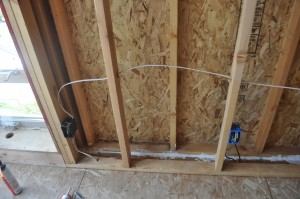 Zero-energy homes usually require a wall system with an insulating value of R-30 to R-40, at least in cold, heating-dominated climates. In Part 1 of this series, I suggested that you can’t go wrong with rigid insulation sheathing or with double-stud walls filled with fibrous insulation. While the double-stud approach does have advantages, it also has a potential drawback – uncertainty about moisture condensation in thick walls.
Zero-energy homes usually require a wall system with an insulating value of R-30 to R-40, at least in cold, heating-dominated climates. In Part 1 of this series, I suggested that you can’t go wrong with rigid insulation sheathing or with double-stud walls filled with fibrous insulation. While the double-stud approach does have advantages, it also has a potential drawback – uncertainty about moisture condensation in thick walls.
My experience over the last ten years has shown that wood-framed walls are moisture tolerant. Even though condensation does occur, wood fiber is capable of storing a considerable amount of winter wetting until it can dry out the following summer. As long as the moisture content of framing and sheathing returns to normal, decay won’t occur. When you purchase kiln-dried lumber, it arrives on the site with about 15 percent moisture content and dries further after construction. When condensation occurs on framing, plywood or OSB, the wood fibers can absorb this liquid water until the wood becomes saturated at about 21 percent moisture content. Only then does the surface become wet enough to support decay. The amount of time above fiber saturation is a key factor in whether decay takes hold.
These ideas were supported by a 2015 study conducted by Building Science Corp. The report includes lots of hemming and hawing and conservative conclusions, but the main take away is that while double walls do indeed get a little moist, they will not support decay because in cold, heating dominated climates, the wall assembly will dry to the inside. If there is condensation on the inside of the wall sheathing during cold weather, it will be too cold to support decay organisms
Bill Hull of W.H. Hull Company in Bend, Oregon, who specializes in double-stud walls, opened up a 12-inch-thick wall cavity on the north side of a one-year-old home. There was absolutely no sign of wetting, let alone decay, even though it was a bathroom wall.
In fact, I recently completed my own home with 10-inch double-stud walls. During construction, I embedded a temperature and humidity sensor in the north wall to track moisture. I expect to see some of the conditions that might cause condensation, however, I would be very surprised to see decay. I’ll update this post with the results in March.
We have two great wall systems to help us reach the zero energy goal in residential buildings. Walls with exterior foam sheathing provide great energy performance and provide a strong defense against condensation. Double-stud walls also give superior performance, including resistance to moisture damage.
For more detailed information, check out the full Building Science Corporation study or if you’re short on time, read the study synopsis at Energy.gov
– Bruce Sullivan, Building Science Consultant, www.basezero.biz/
